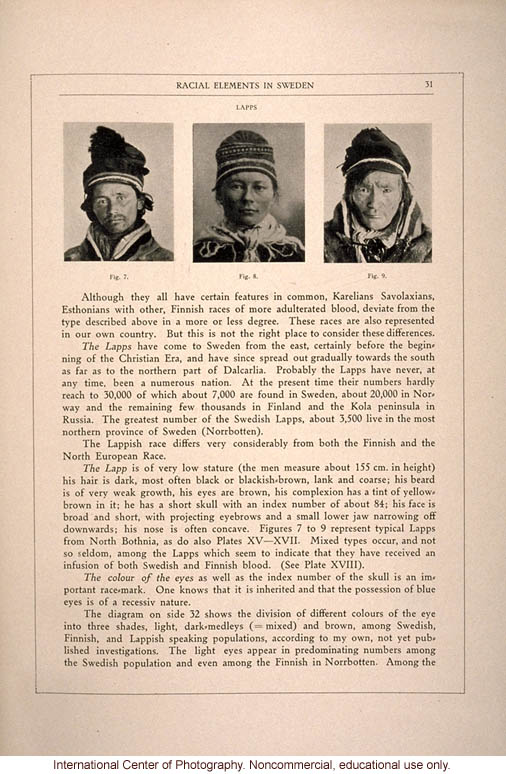[hairline boxed text]
Racial Elements in Sweden 31
[hairline score]
Lapps
[3 photos][photo captions] Fig. 7.
Fig. 8.
Fig. 9.
Although they all have certain features in common, Karelians Savolaxians, Esthonians with other, Finnish races of more adulterated blood, deviate from the type described above in a more or less degree. These races are also represented in our own country. But this is not the right place to consider these differences.
[italics]The Lapps[end italics] have come to Sweden from the east, certainly before the beginning of the Christian Era, and have since spread out gradually towards the south as far as to the northern part of Dalcarlia. Probably the Lapps have never, at any time, been a numerous nation. At the present time their numbers hardly reach to 30,000 of which about 7,000 are found in Sweden, about 20,000 in Norway and the remaining few thousands in Finland and the Kola peninsula in Russia. The greatest number of the Swedish Lapps, about 3,500 live in the most northern province of Sweden (Norrbotten).
The Lappish race differs very considerably from both the Finnish and the North European Race.
[italic]The Lapp[end italic]is of very low stature (the men measure about 155 cm. in height) his hair is dark, most often black or blackish-brown, lank and coarse; his beard is of very weak growth, his eyes are brown, his complexion has a tint of yellow-brown in it; he has a short skull with an index number of about 84; his face is broad and short, with projecting eyebrows and a small lower jaw narrowing off downwards; his nose is often concave. Figures 7 to 9 represent typical Lapps from North Bothnia, as do also Plates XV-XVII. Mixed types occur, and not so seldom, among the Lapps which seem to indicate that they have received an infusion of both Swedish and Finnish blood. (See Plate XVIII).
[italic]The colour of the eyes[end italics] as well as the index number of the skull is an important race-mark. One knows that it is inherited and that the possession of blue eyes is of a recessiv[sic] nature.
The diagram on side 32 shows the division of different colours of the eye into three shades, light, dark-medleys (= mixed) and brown, among Swedish, Finnish, and Lappish speaking populations, according to my own, not yet published investigations. The light eyes appear in predominating numbers among the Swedish population and even among the Finnish in Norrbotten. Among the
[end]


